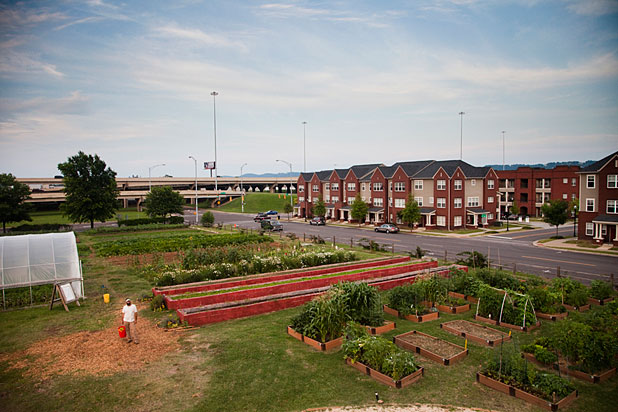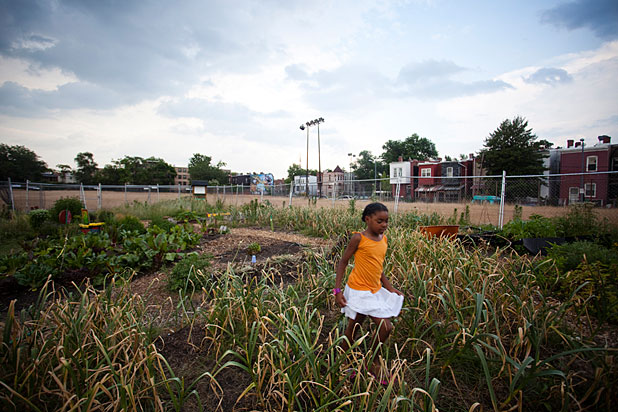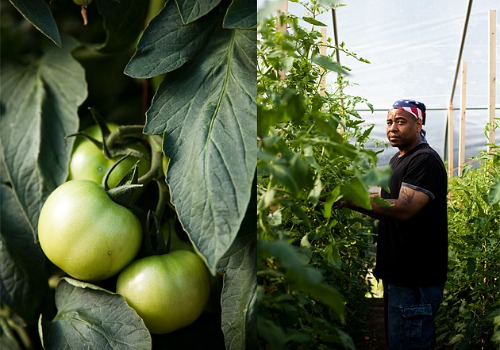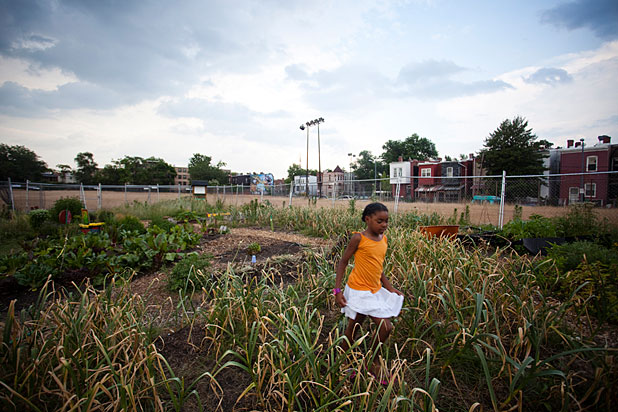 Neighbors used to avoid this area in the LeDroit Park neighborhood of Washington, DC, the site of an abandoned school, before Common Good City Farm grew there.(Photos ©Michael Hanson)
Neighbors used to avoid this area in the LeDroit Park neighborhood of Washington, DC, the site of an abandoned school, before Common Good City Farm grew there.(Photos ©Michael Hanson)
“You got any more arugula?”
A middle-aged man has just walked up to the street side of the chain-link fence. He peers through the gaps in the rusted metal and looks into the Common Good City Farm, where Murray Schmechel, 76, and Troy Coleman, 47, are laying irrigation tubing down rows of winter squash and hot peppers.
“I don’t have any right now, but come on in and work for a minute next time you come around and we’ll probably have some,” Murray says.
“Alright. I might, but later. It’s too hot right now,” says the man on the street.
He’s right. It is too hot right now. A heat wave has followed us up the east coast from New Orleans (105 degree heat index), through Birmingham, and now into Washington D.C. It’s like the sun’s getting all fired up in approach to its solstice. But Troy and Murray are out here at Common Good City Farm (CGCF), as are six or seven other volunteers and a few children.
I can’t help but notice the mix of people on this city block. Outside the fence, on the streets and sidewalks and in the doorways of the graffiti’d brick apartments stand some of the residents. It’s cooler outside than in the air-conditioner-less rooms inside. The people out here don’t seem interested in growing food, or in what the farm stands for. I ask a few middle-aged folks on the street corner if they go into the farm or get food from it. They say they used to grow food when they were young, but not anymore, not even as an aside in the garden outside their front door. They say they mostly see kids from the neighborhood in there.
“We’ll ask people what they want to see grown and hear ‘barbeque ribs.’ But everyone likes tomatoes, okra, snap peas. When you bring that out of them, the gardening that they know, that their parents or grandparents might have grown — then they start to get it.”
Inside the fence, the people pruning and watering and volunteering at Common Good have that idealistic, world-changing energy. Conclusions come easily, especially when you’ve become accustomed to swooping in, seeing a project, and getting its vibe in only a day or two. So I worried about this one for the first afternoon. Common Good City Farm is young, yes — in its second year on this plot after years growing food nearby at the 7th Street Garden — but is it a pat-on-the-back project for people who live elsewhere? One of those “museum” farms Katherine Kelly talked about in Kansas City?
Common Good sits on a former elementary school’s baseball field, which was a row of houses before that. The school, abandoned years ago, had become a dark, lurking place for trouble, the type of outpost that LeDroit did not need, considering its precipitous slide into blight that bottomed out about ten years ago. The area is cleaning up — the apartments across the street from CGCF are being gutted and rehabbed — but it’s still a food desert, with no grocery stores or easy access to fresh food. A third of the residents live in poverty, one in five is overweight, and one in ten has diabetes.
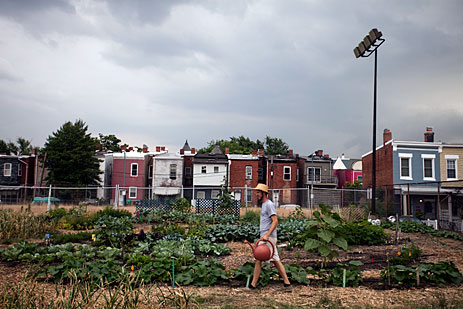 Spencer Ellsworth, Common Good City Farm farm manager and interim directorSo when the neighborhood decided to build a park on the former school property, the civic association considered including a garden project. Nearby, Liz Falk had established 7th Street Garden (video) as a thriving place of food and community growth. So they formed a partnership.
Spencer Ellsworth, Common Good City Farm farm manager and interim directorSo when the neighborhood decided to build a park on the former school property, the civic association considered including a garden project. Nearby, Liz Falk had established 7th Street Garden (video) as a thriving place of food and community growth. So they formed a partnership.
Common Good, in its second season, grows great produce. The volunteers take some of it home. Kids who work in the garden with the education program get fresh fruits and veggies and the Green Tomorrows participants, enrollees who qualify by earning less than the DC living wage, work the farm on Saturdays in return for workshop classes and fresh produce.
“Community gardens are highly concentrated in affluent Northwest D.C. – 80% of them,” says Spencer Ellsworth, 25. Spencer has recently become the farm manager and acting director as they search for a replacement for Liz. “There are also other gardens that are under-utilized. What’s lacking is folks learning how to grow, and why to grow, their own food. That’s a niche the CGCF can reach. That’s a goal — to be able to train folks and spread this. We believe you can put these projects together relatively easily. All you need is the sun, the seeds, the time, the effort, the water, and the community involvement to go with it.
“We’ve made a lot of progress, but we don’t want to just be the people inside the fence,” Spencer continues. “We’ve had to engage the civic association and sometimes even go door to door. We’ll ask people what they want to see grown and hear ‘barbeque ribs.’ But everyone likes tomatoes, okra, snap peas. When you bring that out of them, the gardening that they know, that their parents or grandparents might have grown — then they start to get it.”
 Murray Schmechel and Troy Coleman are neighbors in LeDroit Park. I start to get it as I watch Murray and Troy work together. Murray grew up on a farm in Nebraska and worked in horticultural therapy for at-risk teens in Texas, as well as being a minister with the church for 24 years. He moved to DC, where his son lives, when he retired. He picked LeDroit Park because there was this farm project to work on. He’s the most knowledgeable volunteer in the history of volunteers.
Murray Schmechel and Troy Coleman are neighbors in LeDroit Park. I start to get it as I watch Murray and Troy work together. Murray grew up on a farm in Nebraska and worked in horticultural therapy for at-risk teens in Texas, as well as being a minister with the church for 24 years. He moved to DC, where his son lives, when he retired. He picked LeDroit Park because there was this farm project to work on. He’s the most knowledgeable volunteer in the history of volunteers.
Troy, meanwhile, has lived in LeDroit Park his whole life. He felt the weight of this neighborhood in his difficult childhood and subsequent dropping out of junior high school. He’s worked maintenance and labor jobs, and is now disabled. Murray and Troy live next door to each other, and one day Murray asked Troy to come help him at the farm.
“He just came and got me,” says Troy. “We’ve been doing this off and on for over a year. I got a bad back. I come out here every blue moon. This here’s the brainiac. When Murray’s got a big project to do, he comes and gets me.”
“You planted most of the tomatoes,” Murray adds. He turns to me, “You know, last year, he’d plant the tomatoes and then he’d say, ‘Grow, dammit!’ It worked. They grew, didn’t they?”
“I take some of the cabbage home, some greens,” says Troy. “I like salad. I don’t know anything about this, and he takes me out and shows me this stuff.”
Murray is a farmer, a gardener. He grows things and he knows that takes time. Watching him and Troy and the man at the fence, I see the better reality here, the one that’s hard to catch in a quick farm tour. Murray sees it, too, and, without me asking, he explains it, partly to me and partly to Troy:
“Troy, you moved in, and you and I got to talking to each other. It’s like that guy at the fence. He came over here the other day and asked me for money. I said, ‘No, but I can give you some greens.’ And he just came back here today and said he loved the greens and he wants some more. I told him to come out and work a little. So it starts slow. Maybe next time he’ll come out here and work for a bit and get some more greens.”
“We’re trying to get the neighbors involved,” says Troy. “Trying to get them to stop walking in their houses and closing their doors. We get some kids out here and when we start seeing the teenagers involved, oh man, that’s a home run.”
All content ©Breaking Through Concrete, adapted with permission. For information regarding use of images, video, or text, please contact btctour@mail.com.
